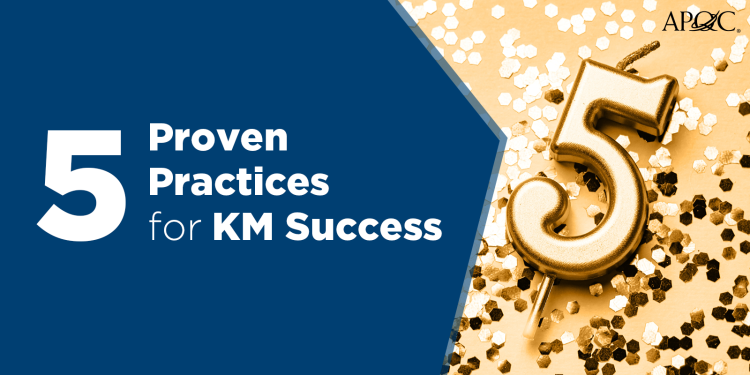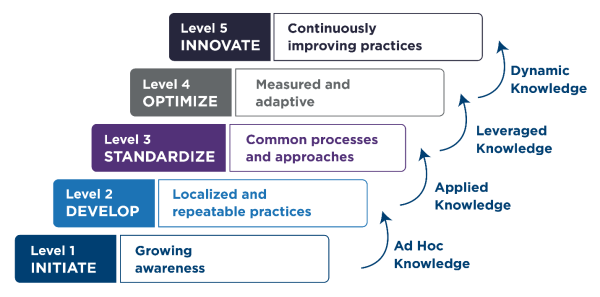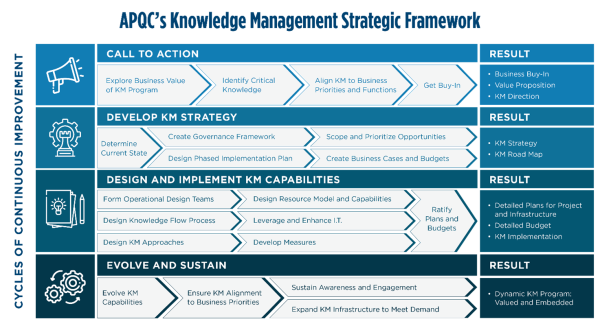
Whether you are starting a new knowledge management (KM) program in 2024 or continuing to evolve and expand an existing program, it is critical to have a documented KM strategy. A clearly articulated strategy and roadmap ensure the KM team remains focused on goals that support the business, helps secure stakeholder buy-in and engagement, and provides alignment and credibility to the work of the KM team.
Organizations with mature knowledge management (KM) programs almost always have a clearly defined strategic direction for their KM capabilities. And now, you can too. Showing strategic alignment will improve the value of each KM capability you implement and enhance the benefit of KM to the business. Through ongoing research, APQC has identified five ways that leading organizations design, implement, and evolve their KM strategies:
1. Start Small: Focus on a specific business need or challenge.
Knowledge Management is a journey, not a project or a tool. Leading organizations in KM select a specific business need and then target a partnership with that function. Mercer, a Marsh McLennan business and professional services organization, credits their high level of KM maturity and ongoing success to their use of Agile solution development. When the company began migrating to Microsoft 365 and SharePoint in 2022, it adopted an Agile approach to project management. Now, they continually leverage the Agile philosophy in small chunks. By making incremental improvements and collecting regular feedback, they’ve adapted and now move forward at a more cyclical, faster pace.
While experimentation and agile methods apply well in technology implementations, this approach rings true with any KM capability. For example, you can start communities of practice in a specific function to address a specific critical knowledge gap. By focusing on a specific function rather than the whole, there is more opportunity for success in proving the concept, collecting viable feedback, evolving the capability, and com
2. Keep Your Eye on the Prize: Align the KM vision and objectives to the overall business strategy.
Aligning a proven KM capability such as communities of practice, lessons learned knowledge base or robust content management solution to an immediate business need is a great starting point for setting a strategic direction for KM. Rapidly maturing KM programs build on this by continuing to scale capabilities that support business objectives, followed by developing and then aligning the KM vision to the business strategy. This ultimately helps in establishing a KM brand that reflects an organizational vision. At Novartis, a pharmaceutical company, the KM team develops proposals for their business that begin with a use case to solve a specific challenge in the business and shows where KM can align to their strategy and add value. With a focus on partnership and consultation within the business, the work of their team continues to expand.
3. Know Where You Stand: Assess and benchmark your KM program.
KM strategy is not a “one and done”. Leading organizations continually assess their KM maturity using APQC’s Knowledge Management Capability Assessment Tool and benchmark against peers and third-party frameworks to identify critical needs, measure progress against goals and validate investments. APQC’s research shows that organizations who regularly assess and benchmark their KM programs not only improve their level of KM maturity but outperform peers when it comes to aligning KM to business strategy and expanding KM to new domains over time.
4. Remain flexible: Adapt to changes in the business or external disruption.
APQC has found that mature KM programs reevaluate and refresh their priorities regularly so that the KM strategy evolves in line with the business. This ability to adjust enables KM to continue providing value in moments of disruption, whether it comes in the form of a new technology, rapid growth, supply chain outages, environmental factors, or something else.
2023 proved to be a challenging year for most organizations with the frenzy of generative AI. Resetting strategies with disruptions like AI are becoming the rule instead of the exception. APQC’s research is finding most KM teams are at the center of helping organizations prepare for AI, including defining use cases, experimenting with and implementing AI solutions that bring value to their organization.
5. Onward and Upward: Evolve and scale your KM strategy.
Finally, leading organizations expand their KM efforts as opportunities arise by leveraging partnerships and buy-in from early successes, while continuing to respond to new business needs. For most mature KM programs, the ultimate goal is a consistent enterprise program that promotes standardization and takes advantage of scale. Leveraging APQC’s Knowledge Management Framework is a great place to start and track your progress as you expand to an enterprise level.
Don’t go at it alone. We’ve done the heavy lifting for you. Tap into guidance and best practices on assessing, building, and implementing your KM strategy and capabilities in Strategic Planning for Knowledge Management. And be on the lookout for opportunities to participate in upcoming research and events like our webinar focused on 2024 Top KM Priorities and Predictions.

